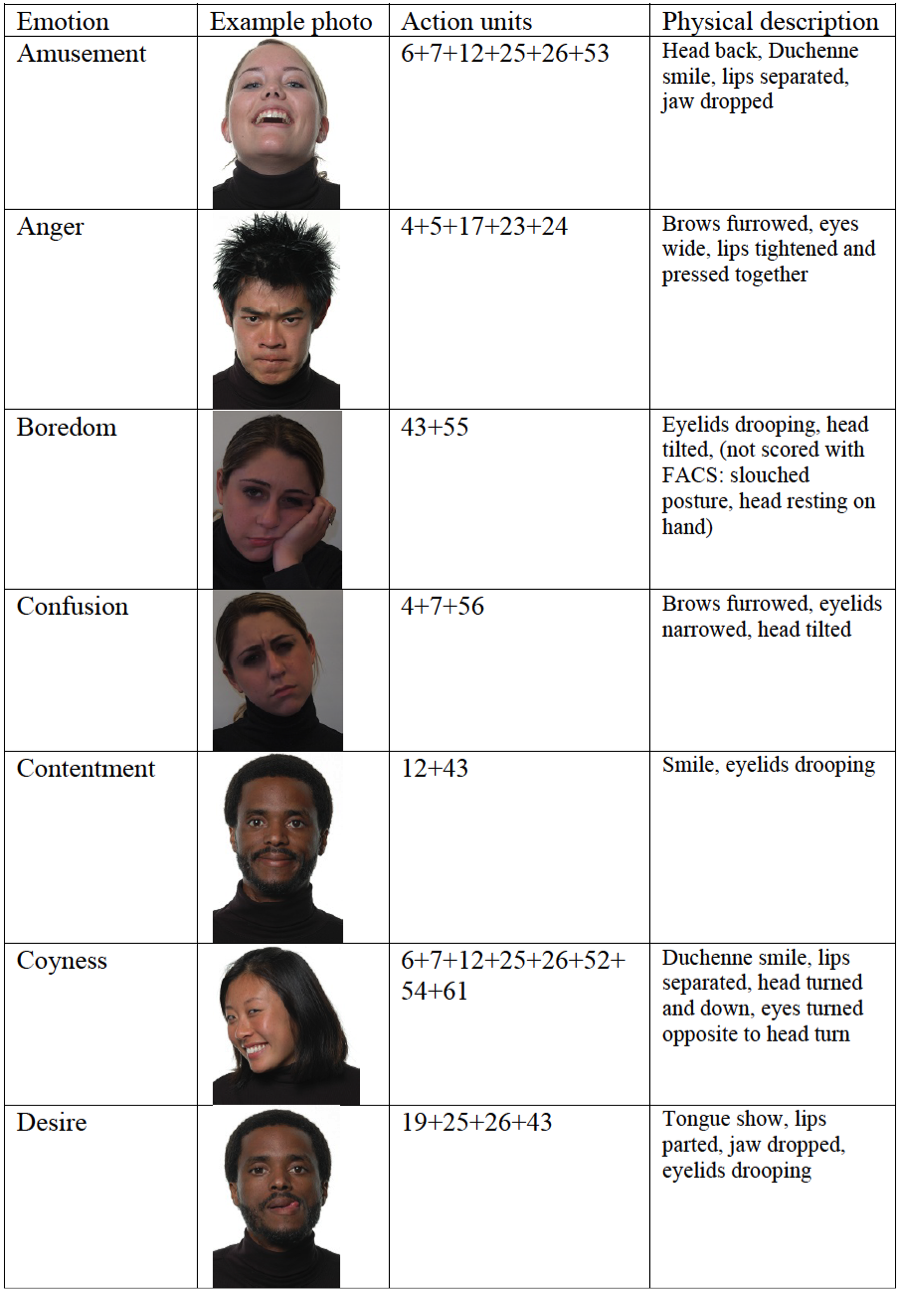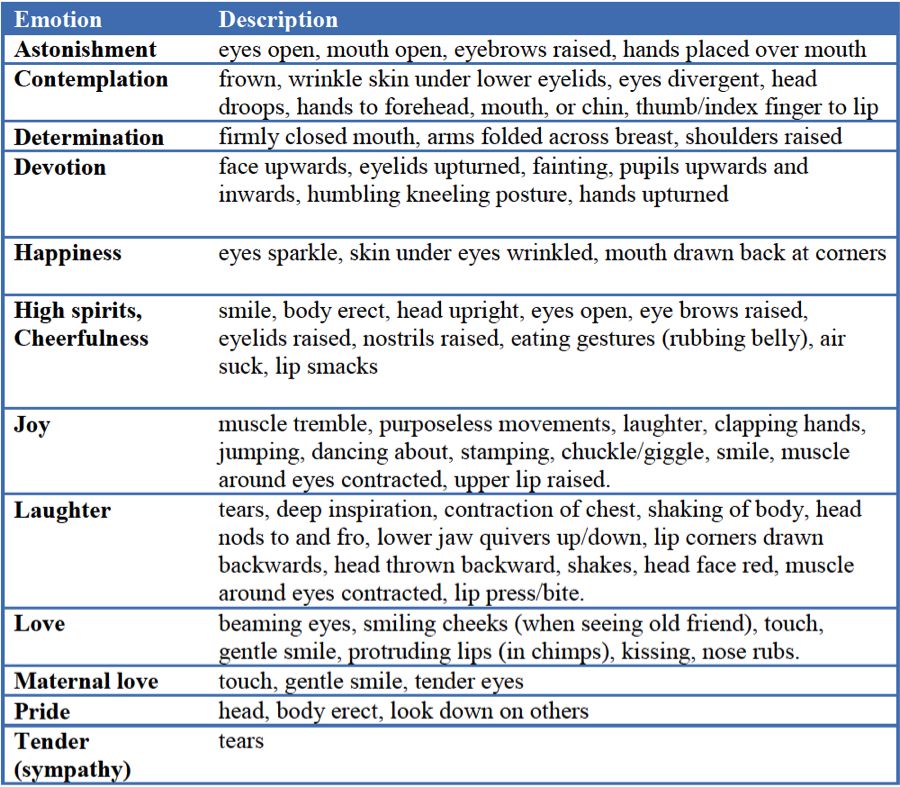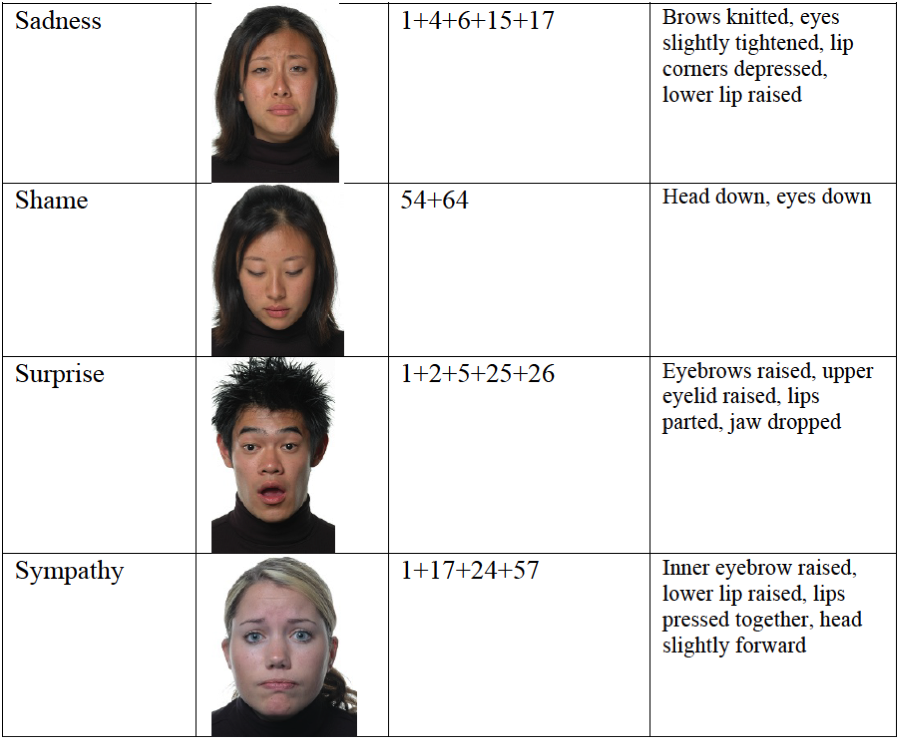

 Dacher Keltner, Department of Psychology, University of California Berkeley & Daniel T. Cordaro, Department of Psychology, Yale University
Dacher Keltner, Department of Psychology, University of California Berkeley & Daniel T. Cordaro, Department of Psychology, Yale University
Copyright © by Dacher Keltner & Daniel T. Cordaro, All Rights Reserved. The current version benefitted from the editorial efforts of Andrea Scarantino. An expanded version will appear in a volume published by Oxford University Press.
Introduction
August 2015 – Basic Emotion Theory has proven to be a highly fruitful yet controversial set of ideas in the science of emotion, generating vigorous debate over the past 30 years (Barrett, Lindquist, & Gendron, 2007; Ekman, 1992; Ortony & Turner, 1990; Russell, 1994). At its core, Basic Emotion Theory consists of specific theses concerning (1) what the emotions are – in general terms, they are brief, unbidden, pancultural functional states that enable humans to efficiently respond to evolutionarily significant problems – and (2) how scientific research is to differentiate distinct emotions from one another – in expression, peripheral physiology, appraisal, and neural process (Ekman, 1992; Ekman & Cordaro, 2011; Ekman & Davidson, 1994).
Here, we focus on an especially contentious sub-domain of Basic Emotion Theory, namely its specific claims regarding emotional expression. Within this tradition, it is more specifically assumed that expressions of emotion: 1) are brief, coherent patterns of facial behavior that covary with distinct experiences; 2) signal the current emotional state, intentions, and assessment of the eliciting situation of the individual; 3) manifest some degree of cross-cultural universality in both production and recognition; 4) find evolutionary precursors in the signaling behaviors of other mammals in contexts similar to the social contexts humans encounter (e.g., when signaling adversarial intentions); and 5) covary with emotion-related physiological responses (for summaries, see Ekman, 1994; Hess & Fischer, 2013; Keltner & Haidt, 2001; Keltner & Kring, 1998; Matsumoto et al., 2008).
Much of the original support for Basic Emotion Theory comes from the well-known studies of Ekman and Friesen in New Guinea (Ekman, Sorenson, & Friesen, 1969). Using still photographs of prototypical emotional facial expressions, Ekman and Friesen were able to document universality in the production and recognition of a limited set of “basic” emotions, including anger, fear, happiness, sadness, disgust and surprise (for review, see Matsumoto et al., 2008). Subsequent critiques have raised questions about the degree of universality in the recognition of these emotional facial expressions (Russell, 1994), about what such expressions signal (Fridlund, 1991), about the response formats in the studies (Russell, 1994), and about the ecological validity of such exaggerated, prototypical expressions.
These productive debates have inspired a next wave of research on emotional expression, which advances Basic Emotion Theory in fundamental ways. In this essay we summarize – in broad strokes – what has been learned in the past 20 years of empirical study — and how the evidence yields a new set of propositions concerning the nature and universality of emotional expression within the framework of Basic Emotion Theory.
Emotional Expressions are Multi-modal, Dynamic Patterns of Behavior
Central to Basic Emotion Theory is the assumption that emotions enable the individual to respond adaptively to evolutionarily significant threats and opportunities in the environment – the cry of offspring, a threat from an adversary, pursuing sexual opportunity in a social setting of rivals and potential mates (Ekman, 1992; Keltner & Haidt, 2001). Emotions enable such responses primarily through shifts in peripheral physiology (Levenson, Ekman & Friesen, 1990), patterns of cognition (Oveis, Horberg, & Keltner, 2010), movements of the body (e.g. the proverbial fight or flight response), and expressive behavior that coordinates social interactions through the information it conveys and responses it evokes in others (e.g., Keltner & Kring, 1998; van Kleef, 2009).
Within this framework, emotions are fundamentally about action (Frijda, 1986). Emotions enable people to react to significant stimuli in the environment (or within themselves), in complex patterns of behavior involving multiple modalities – facial muscle movement, vocal cues, bodily movements, gesture, posture, and so on. For example, studies capturing experiences of sympathy find that this brief state involves bodily movements forward, soothing tactile behavior, oblique eyebrows, a fixed pattern of gaze, vocalizations, and skin-to-skin contact when sympathy leads to embrace (Goetz, Keltner, & Simon-Thomas, 2010).
Early studies of emotional expression, and the controversies they engendered, largely focused on the meaning of static portrayals of prototypical configurations of facial muscles of anger, disgust, fear, sadness, surprise, and happiness (Ekman, 1994; Russell, 1994). In the last 20 years, the scientific study of facial expressions has moved significantly beyond static portrayals of six emotions, revealing that emotional expressions are multimodal, dynamic patterns of behavior, involving facial action, vocalization, bodily movement, gaze, gesture, head movements, touch, autonomic response, and even scent (Keltner et al., in press).
Notably, the notion that emotional expressions are multimodal patterns of behavior is evident in Charles Darwin’s own rich descriptions of the expressions of over 40 emotional states (Keltner, 2009), a portion of which we summarize in Table 1 (with focus on positive emotions).

We notice here that Darwin did not focus on what Ekman (1992) once called momentary facial expressions, the sorts of expressions that can be captured with a snapshot, but rather on extended and multimodal dynamic patterns of behavior, in which the signal consists of a sequence of facial and non-facial actions that only collectively and over time convey the relevant message.
Focusing on more modalities than facial expression alone has enabled the discovery of new emotional expressions. For example, gaze patterns and head movements covary with the experience and signaling of embarrassment (Keltner, 1995), pride (Tracy & Robins, 2004), and awe (Campos et al., 2013), as we detail below. Thinking of emotional expressions as dynamic multimodal patterns of behavior also points to intriguing new questions (e.g., Aviezer, Trope, & Todorov, 2012).
What is the relative contribution of different modalities to the perception and signal value of emotional expressions (e.g., Flack, 2006; Scherer & Ellgring, 2007)? Why is it that certain emotions are more reliably signaled in multiple modalities, whereas other emotions are only recognized in one modality? For example, sympathy is reliably signaled in touch and the voice, but less so, in the face (Goetz et al., 2010). It is nearly impossible to communicate embarrassment through touch, but it is reliably communicated in patterns of gaze, head, and facial behavior.
There are More Emotional Expressions than the “Basic” Six
Critical to Basic Emotions Theory is the question of which emotions have distinctive signals. Evidence germane to this question informs taxonomies of emotion (e.g., Keltner & Lerner, 2010) and the search for emotion-specific responses in other systems, such as neuroendocrine or autonomic response systems (see below).
Past studies focused on figuring out momentary expressions captured by still photographs. As a result, only the “basic six” emotions – anger, disgust, fear, sadness, surprise, and happiness – emerged as having clear distinctive signals. But if emotional expressions are, as we claim and as suggested by Darwin, multimodal and dynamic, many more emotions may have distinctive signals, which could consist of facial changes over time in combination with other changes (e.g. vocal changes).
In recent years, dozens of studies have sought to differentiate the expressions of emotions other than the “basic” six, expanding the focus to modalities such as touch, voice, and artistic portrayal. In emotion recognition paradigms, participants attempted to choose the right label to designate an emotion-related facial expression, vocalization, or piece of music. In emotion production studies, participants attempted to communicate emotions to a naïve observer, who was tasked with guessing the emotion expressed. In emotion encoding studies, behavioral analyses ascertained whether the experience of an emotion was expressed in different behaviors than closely related states.
In Table 2, we summarize this new literature, indicating whether studies reveal that the facial, vocal, tactile, and music-related expressions of the emotion can be differentiated from expressions of other emotions. In the respective columns, “yes” indicates that the evidence suggests that the emotion is communicated in a modality at above chance levels; “no” indicates that the emotion cannot be reliably communicated in the modality. These data make the case for distinct expression of 24 emotional states when different modalities are considered, although we note that few if any studies have looked at multimodal expressions of emotion.

This new literature reveals that there are more emotions than the “Basic Six” and that emotions can be expressed in non-facial modalities. These discoveries speak to the promise of a multimodal approach to emotional expression anticipated in Table 1. Several critical questions await attention. Most notably, few if any production studies have examined how the different modalities of expression – face, voice, touch, body and gaze activity – covary during emotional expressions. Few if any emotion recognition studies have addressed whether multimodal expressions are more reliably recognized than single modality expressions, for example in the face or voice – largely the focus of research to the present date.
Patterns of Emotional Expression Vary Within Emotion and Across Individuals and Cultures
Within traditional Basic Emotion Theory, the focus has been on prototypical facial expressions, namely facial expressions that are “best examples” of the expressions associated with an emotion (Ekman, 1992). This has been a prerequisite of the still photograph method, so profoundly influential in the field, which demanded focusing on behaviors that characterize paradigmatic cases of the emotion and can be captured with a snapshot (e.g., the tightened lips during prototypical episodes of anger).
As critics have pointed out, this focus has led to a neglect of less prototypical expressions of emotions, namely other behaviors that vary more in whether or not they occur during an emotional experience (e.g. the face touch during embarrassment). These latter behaviors are more likely to vary across context, individuals, or cultures. Once we expand the focus from prototypical momentary expressions to all extended expressions of any given emotion, it becomes clear that there is no one-to-one correspondence between a specific set of facial muscle actions or vocal cues and any and every experience of an emotion; instead, this approach suggests probabilistic associations between the multimodal behaviors and the occurrence of the emotion.
One clear implication is that there will be significant variation within a category of emotion (e.g., embarrassment, awe) in the patterns of behavior that covary with the occurrence of the emotion, most typically ascertained with self-report measures. For example, in an early study of the expressive behavior of embarrassment, it was found that different patterns of behavior arose during the experience of embarrassment (Keltner, 1995; for similar evidence concerning pride, see Tracy & Robins, 2004). Most displays of embarrassment involved gaze down, head movements down, and awkward smiles, but some involved face touching, some involved shoulder shrugs, and some involved pained, self-conscious vocalizations.
Additionally, the more expressions of embarrassment include the full complement of prototypical features – the gaze down, head movement down, awkward smile, face touch–, the more naïve observers reliably recognize the emotion in the display. Studies of emotion-related tactile contact similarly find variation in the patterns of tactile behavior (location, pressure, configuration of hand) within the expression of one emotion, such as gratitude or sympathy (Hertenstein et al., 2006).
In moving away from the assumption that there is necessarily a one-to-one correspondence between emotional experience and specific expressive behaviors, empirical research can capture different sources of emotion-related variation in expressive behavior. A first is to study subtypes of an emotion, which vary according to specific appraisal themes. Emotion concepts such as “embarrassment” or “awe” or “anger” actually refer to a variety of states within that emotion family (for example, people experience awe that varies in the sense of beauty, fear, supernatural causation; Keltner & Haidt, 2003). The challenge for future research will be to map specific variations of an emotional state – such as awe involving threat versus no threat – to specific elements of the pattern of expressive behavior.
A second source of variation consists of cultural differences in the multimodal expression of emotions. As an illustration, in one recent study participants in five different cultures – China, India, Japan, Korea, and the USA – heard twenty-two emotion-specific situations in their native language and were asked to express the emotion in whatever fashion they desired, which could include facial, vocal, or bodily expressions (Cordaro, 2013). The only instruction was that the expressions were to be nonverbal. Over 5500 facial expressions, bodily movements, gaze movements, hand gestures, and patterns of breathing were coded using an expanded Facial Action Coding System (Ekman & Friesen, 1978), and a large subset of these was analyzed for patterns across and within cultures.
For all emotions studied, certain collections of expressive behaviors were frequently observed across all five cultural groups, which were deemed International Core Sequences – the prototypical elements of the multimodal hyperspace of variation in emotional expression. Across cultures the expression of awe, for example, tended to involve the widening of the eyes and a smile as well as a head movement up. Across cultures, head nods expressed interest. Confusion was generally expressed with behaviors including furrowed brows, narrowed eyes, and a head tilt. At the same time, there were certain patterns of behavior that were observed within, but not between, cultures, and these were deemed Culturally Varying Sequences. These patterns of expressive behavior were unique to the culture, and have been called “emotion accents” in other studies (Elfenbein, 2013). We propose that these cultural accents are shaped by display rules that predicate the amplification or masking of emotional displays according to the value attached to the specific emotion.
Search for Neurophysiological Correlates of Emotional Expression
Within Basic Emotions Theory, it is assumed that emotions involve emotion-specific physiology, which enable specific behaviors in response to eliciting stimuli – flight, skin-to-skin contact, the widening of the eyes to take in more information, clasping and striking. On this view, expressive behaviors are elements of more complex, emotion-specific patterns of action, useful in our evolutionary past (e.g., Darwin, 1872; Shariff & Tracy, 2011). This analysis suggests that patterns of expression should covary with activation in different neurophysiological systems that are conserved across mammals. Early studies of emotion-specific physiology focused on a limited set of emotions and select measures of peripheral physiology – heart rate, skin conductance, temperature of the skin (Levenson, Ekman & Friesen, 1990).
New discoveries of multimodal patterns of expression of a far wider array of emotions than the basic six have enabled new areas on inquiry in the search for emotion-specific physiology. For example, brief nonverbal displays of love (Duchenne smile, head tilt, open handed gestures) correlate with oxytocin release, whereas cues of sexual desire (lip licks, lip puckers) do not (Gonzaga et al., 2006), a finding that is in keeping with functional analyses of oxytocin as a motivator of commitment and the provision of care in mammalian species (Keltner et al., 2014).
Sympathy-related oblique eyebrow movements relate to increased activation in the vagus nerve, a branch of the parasympathetic autonomic nervous system that supports care-giving in mammals (Eisenberg et al., 1989; Stellar, Cohen, Oveis, & Keltner, 2015). Again, this is in keeping with functional analyses of sympathy as a caregiving emotion. Still other studies have documented that dominance-related postural expansion associated with pride elevates levels of testosterone, a hormone thought to be involved in the signaling of elevated status (Carney, Cuddy, & Yap, 2010).
In Table 3 we summarize these findings. For example, the cytokine system is part of an inflammation response and is associated with submissive responses on nonhuman species, and shame in humans (Dickerson & Kemeny, 2004), and we would suggest, shame-related displays. Recent self-report studies find unique associations between cold shivers and fear and disgust, and goosebumps (piloerection) and awe (Campos et al., 2013; Maruskin et al., 2012). By integrating studies of multimodal expressions for a variety of emotions other than the basic six with advances in neurophysiology, new insights are gained into emotion-specific physiology. Critical questions await empirical attention. Most notably, it will important to examine the temporal sequences in which experience, expression, and emotion-specific physiology unfold, and the degree of coherence between these systems.

Mammalian Precursors to Human Emotional Expression
Critical to Basic Emotions Theory is the notion that human emotional expression arose during the process of mammalian evolution, and by implication, that there should be compelling homologies between human and non-human display behavior. Careful cross-species comparisons between human and nonhuman expressive behavior have revealed functional origins of laughter, smiling, embarrassment, affiliative cues involved in love, sexual signaling, threat displays, and dominance (for review see Keltner et al., in press). Careful analyses of nonhuman vocal display find distinct displays for sex, food, affiliation, care-giving, and threat (Snowdon, 2003).
These cross-species comparisons are critical to functional claims so central to Basic Emotions Theory: that emotional expressions serve specific functions within social contexts common to many mammals – for example, that human embarrassment resembles the behaviors of other species’ appeasement displays, and triggers similar patterns of conflict de-escalating reconciliation (Keltner & Buswell, 1997). This search for mammalian precursors, an enduring theme in Basic Emotions Theory, points to a means to understand the deeper origins of human emotion, providing suggestive evidence of what patterns of mammalian social behavior gave rise to human emotional expression.
For example, it is interesting to speculate how human expressions of gratitude involved in touch (Hertenstein et al., 2006) trace back to the grooming exchanges and food sharing in primates that support reciprocal sharing and cooperation (de Waal, 1996). It is provocative but speculative to consider how the contexts in which nonhuman piloerection occur might inform the understanding of the evolution of awe. How do rodent displays of shuddering and shivering give rise to our own shudders of social disgust? Looking to nonhuman species is a critical means by which Basic Emotions Theory reveals the origins of different emotions.
Gradients of Recognition in Universal Recognition of Emotional Expression
Emotion recognition studies have sought to ascertain the extent to which emotional expressions – facial expressions and vocalizations in particular – are recognized in different cultures (Gendron et al., 2014; Haidt & Keltner, 1999; Sauter et al., 2014). Subsequent critiques of this literature have brought into focus the limitations of forced choice paradigms, the need to study more ecologically valid displays, and the continuing need to study cultures who have not been influenced by media portrayals of emotional expression (Gendron et al., 2014; Haidt & Keltner, 1999; Russell, 1994; Sauter et al., 2014).
Yet another advance in this area of research is the notion that emotions vary in the degree to which they can be reliably signaled, in the sense that there are gradients of recognition (Haidt & Keltner, 1999; Russell, 1994). As one illustration, in a recent study, Cordaro (2013), guided by the emotion expression taxonomy represented in Table 4, produced simple, one sentence, universally understood stories of 18 emotions and presented them to naïve observers in 10 cultures: China, Japan, Korea, New Zealand, Germany, Poland, Pakistan, India, Turkey, and the United States. After reading the story in their native language, the participants viewed four static photos of emotional displays expressed in the face and body. One of these photos was the hypothesized display, the second photo was the physiologically-closest “basic” emotion to the hypothesized display, and the other two photos were randomly selected within-valence confounds. Those participants were required to choose the best photograph that represented the emotion in the story, or select “none of the above” if none of the expression photos matched the story. The photos are portrayed in Table 4, and the data from this study, summed across cultures, are presented in Figure 1. In most cases, participants reliably selected the target display at above-chance rates, despite the presence of within-valence confounds and a physiologically similar “basic” emotion confound.((The text from “Yet another advance….” to “emotion confound” in the section “Gradients of Recognition in Universal Recognition of Emotional Expression” was added on Nov 11 2016 and it is worded differently from the text that appeared originally. The original article, with the changes highlighted in yellow, can be found here: http://emotionresearcher.com/wp-content/uploads/2015/08/Keltner-and-Cordaros-Original-Paper-With-Changed-Text-Highlighted.pdf))


The dashed lines represent levels of recognition that would be observed by chance guessing alone, which would be 20% given that participants chose one label from five options in each judgment. What one can see in Figure 1 is clear evidence that when static photos capture head movements, gaze activity, and face touching, many more emotions than the basic six can be recognized, even in static photos, as we have been arguing.
These data also illustrate something systematically observed in nearly every recognition study: some emotions are more easily recognized than others (e.g. boredom is more easily recognized than interest). Framing the debate about the recognition of emotion across cultures in either/or terms does not represent what the evidence more typically reveals, that there are gradients of recognition, with some emotions more reliably recognized than others.
Toward the Future Empirical Study of Emotional Expression
The study of emotional expression has changed dramatically in the past 20 years. The field is now investigating a much wider array of emotions and how they are expressed in dynamic, multimodal patterns of behavior. Significant advances have been made in understanding the neurophysiological correlates of these patterns of behavior, and their homologues in other mammals.
We end with several critical questions. First, it is striking how few emotion encoding studies there are wherein researchers study how expressive behavior correlates with emotional experience; instead, almost all studies we have considered have been emotion recognition studies, as illustrated above, or emotion production studies wherein participants are given an emotion concept (“disgust”) and asked to express in nonverbally.
Similarly, few studies have examined how well multimodal expressions of emotion can be recognized, and are universal across cultures. These are critical lacunae in the field. The debates concerning the universality of emotion have been more focused upon similarities and differences in the recognition of facial expressions of the basic six emotions, and vocalizations of a broader array of emotions (Haidt & Keltner, 1999). Almost exclusively, studies of universality have used single modalities: static photos of facial expressions (e.g., Matsumoto et al., 2008) or brief vocal bursts or epochs of emotional prosody (Juslin & Laukka, 2003) or videos of emotional tactile contact (Hertenstein et al., 2006).
Across these kinds of studies emotion recognition across cultures tends to hover between 55 and 70%, where chance guessing would yield accuracy levels between 12.5% and 25% percent, depending on estimates of chance. We believe accuracy levels may typically be higher once multimodal expressions, which are much closer to the natural expressions we should ultimately be focusing on, are presented rather than unimodal expressions.
Finally, it will be important to move beyond emotion matching paradigms, where single emotion words are matched to stimuli, and to move to free response studies that investigate the communicative dimensions of multimodal emotional expressions. The problem with forced choice studies is not only that they inflate consensus (Russell, 1994), but also that they wrongly suggest that what matters from a communicative point of view is only which discrete emotion the subject is experiencing. But it is clear that emotional expressions can signal multiple things besides interior experiences (“I feel grateful”): they can signal intentions (“I would like to kiss you”), relations with the perceiver (“you are more powerful than me”), assessments of the eliciting situation (“the actions of that officer are unjust”), and trait-like tendencies (“I am hostile”).
We suggest that specific expressive modalities may communicate different kinds of information. For example, body movement – expanding versus concave chest – differentiates the displays of pride and shame and would seem to relate to the relational dimension of dominance and submissiveness. Eye contact versus gaze aversion may instead signal behavioral intentions, namely social approach versus withdrawal. Understanding the role of each expressive modality in the communication of distinct types of information will be crucial for understanding how emotions evolved.
Finally, debates over the universality of emotional expressions have too often been carried out in dichotomous terms, with the two sides debating whether expressions are universal. New developments in the study of emotional expression suggest that it is time to move away from such Manichean formulations. The extent to which a certain pattern of expressive behavior is universally produced and recognized in radically different cultures will vary according to the emotion (e.g. anger may be more recognizable than sadness), its modality of expression (e.g. relief may be recognizable in the voice but not in the face), its subtype (e.g. awe about beauty may be more recognizable than awe about supernatural causation) and the culture in which it is presented (e.g. Japanese facial expressions may be better recognized by Japanese people).
We hope that the new perspective we have offered here concerning dynamic, multimodal expressions, grounded in Basic Emotions Theory, sets the stage for studies seeking answers to these and other questions.
References
Aviezer, H., Trope, Y., & Todorov, A. (2012). Body cues, not facial expressions, discriminate between intense positive and negative emotions. Science, 338(6111), 1225-1229.
Barrett, L. F., Lindquist, K. A., & Gendron, M. (2007). Language as context for the perception of emotion. Trends in Cognitive Sciences, 11(8), 327-332.
Botvinick, M., Jha, A. P., Bylsma, L. M., Fabian, S. A., Solomon, P. E., & Prkachin, K. M. (2005). Viewing facial expressions of pain engages cortical areas involved in the direct experience of pain. Neuroimage, 25(1), 312-319.
Bretherton, I., & Ainsworth, M. D. S. (1974) Responses of one-year-olds to a stranger in a strange situation. In M. Lewis & L. A. Rosenblum (Eds.) The origin of fear. (pp. 131-164). New York: Wiley.
Campos, B., Shiota, M., Keltner, D., Gonzaga, G., & Goetz, J. (2013). What is shared, what is different? Core relational themes and expressive displays of eight positive emotions. Cognition & Emotion, 27,37-52.
Carney, D. R., Cuddy, A. J., & Yap, A. J. (2010). Power posing brief nonverbal displays affect neuroendocrine levels and risk tolerance. Psychological Science, 21(10), 1363-1368.
Cordaro, D. T. (2013). Universals and cultural variations in expression in five cultures. Unpublished Doctoral Dissertation, University of California, Berkeley.
Darwin, C. (1872/1998). The expression of the emotions in man and animals (3rd ed.). New York: Oxford University Press.
De Waal, F. B. (1996). Good natured (No. 87). Cambridge: Harvard University Press.
Dickerson, S. S., & Kemeny, M. E. (2004). Acute stressors and cortisol responses: A theoretical integration and synthesis of laboratory research. Psychological Bulletin, 130(3), 355.
Dubois, A., Bringuier, S., Capdevilla, X., & Pry, R. (2008). Vocal and verbal expression of postoperative pain in preschoolers. Pain Management Nursing,9(4), 160-165.
Eisenberg, N., Fabes, R. A., Miller, P. A., Fultz, J., Shell, R., Mathy, R. M., & Reno, R. R. (1989). Relation of sympathy and personal distress to prosocial behavior: A multimethod study. Journal of Personality and Social Psychology, 57(1), 55.
Ekman, P. E., & Davidson, R. J. (1994). The nature of emotion: Fundamental questions. Oxford University Press.
Ekman, P., & Rosenberg, E. L. (Eds.). (1997). What the face reveals: Basic and applied studies of spontaneous expression using the Facial Action Coding System (FACS). New York: Oxford University Press.
Ekman, P., & Friesen, W. V. (1986). A new pan-cultural facial expression of emotion. Motivation and Emotion, 10(2), 159-168.
Ekman, P., & Friesen, W. V. (1978). Facial Action Coding System: Investigatoris Guide. Consulting Psychologists Press.
Ekman, P. (1992). All Emotions Are Basic. In Ekman & Davidson (Eds.), The Nature of Emotion (pp. 15-19). New York: Oxford University Press.
Ekman, P., & Cordaro, D. (2011). What is meant by calling emotions basic.Emotion Review, 3(4), 364-370.
Ekman, P., Sorenson, E.R., & Friesen, W.V. (1969). Pan-cultural elements in the Facial Display of Emotions. Science, 164, 86-88.
Elfenbein, H. A. (2013). Nonverbal dialects and accents in facial expressions of emotion. Emotion Review, 5(1), 90-96.
Flack, W. (2006). Peripheral feedback effects of facial expressions, bodily postures, and vocal expressions on emotional feelings. Cognition & Emotion, 20(2), 177-195.
Fridlund, A. J. (1991). Evolution and facial action in reflex, social motive, and paralanguage. Biological Psychology, 32(1), 3-100.
Frijda, N. H. (1986). The Emotions. New York: Cambridge University Press.
Gendron, M., Roberson, D., van der Vyver, J. M., & Barrett, L. F. (2014). Cultural relativity in perceiving emotion from vocalizations. Psychological Science, 25(4), 911-920.
Goetz, J. L., Keltner, D. & Simon-Thomas, E. (2010). Compassion: An evolutionary analysis and empirical review. Psychological Bulletin, 136(3), 351-374.
Gonzaga, G. C., Turner, R. A., Keltner, D., Campos, B., & Altemus, M. (2006). Romantic love and sexual desire in close relationships. Emotion, 6(2), 163.
Grunau, R. V., & Craig, K. D. (1987). Pain expression in neonates: facial action and cry. Pain, 28(3), 395-410.
Haidt, J., & Keltner, D. (1999). Culture and facial expression: Open-ended methods find more faces and a gradient of recognition. Cognition & Emotion, 13, 225-266.
Hejmadi, A., Davidson, R. J., & Rozin, P. (2000). Exploring Hindu Indian emotion expressions: Evidence for accurate recognition by Americans and Indians. Psychological Science, 11(3), 183-187.
Hertenstein, M. J., Holmes, R., McCullough, M., & Keltner, D. (2009). The communication of emotion via touch. Emotion, 9(4), 566.
Hertenstein, M. J., Keltner, D., App, B., Bulleit, B. A., & Jaskolka, A. R. (2006). Touch
communicates distinct emotions. Emotion, 6(3), 528.
Hess, U., & Fischer, A. (2013). Emotional mimicry as social regulation. Personality and Social Psychology Review, 17(2), 142–157.
Juslin, P. N., & Laukka, P. (2003). Communication of emotions in vocal expression and music performance: Different channels, same code?. Psychological Bulletin, 129(5), 770.
Keltner, D., & Haidt, J. (2003). Approaching awe, a moral, spiritual, and aesthetic emotion. Cognition & Emotion, 17(2), 297-314.
Keltner, D. & Kring, A.M. (1998). Emotion, social function, and psychopathology. Review of General Psychology, 2(3), 320-342.
Keltner, D. (2009). Born to be good: The science of a meaningful life. New York: WW Norton & Company.
Keltner, D. (1995). Signs of appeasement: Evidence for the distinct displays of embarrassment, amusement, and shame. Journal of Personality and Social Psychology, 68(3), 441-454.
Keltner, D. & Lerner, J. (2010). Emotion. In Fiske, Giblert and Lindzey (Eds.), Handbook of Social Psychology, Volume 1 (pp. 317-342). New Jersey: John Wiley & Sons, Inc.
Keltner, D., & Shiota, M. N. (2003). New displays and new emotions: A commentary on Rozin and Cohen (2003).
Keltner, D., & Bonanno, G. A. (1997). A study of laughter and dissociation: Distinct correlates of laughter and smiling during bereavement. Journal of Personality and Social Psychology, 73(4), 687.
Keltner, D. (1996). Evidence for the distinctness of embarrassment, shame, and guilt: A study of recalled antecedents and facial expressions of emotion. Cognition & Emotion, 10(2), 155-172.
Keltner, D., & Buswell, B. N. (1997). Embarrassment: Its distinct form and appeasement functions. Psychological Bulletin, 122(3), 250.
Keltner, D., Tracy, J., Sauter, D., Cordaro, D., & McNeil, G. (in press). Emotional Expression. In L.F. Barrett (Ed.). Handbook of Emotion.
Keltner, D., & Haidt, J. A. (2001). Social functions of emotions. In Mayne & Bonanno, (Eds.), Emotions: Current Issues and future directions. New York, NY, US: Guilford Press.
Keltner, D., Kogan, A., Piff, P. K., & Saturn, S. R. (2014). The sociocultural appraisals, values, and emotions (SAVE) framework of prosociality: Core processes from gene to meme. Annual review of psychology, 65, 425-460.
Levenson, R. W., Ekman, P., & Friesen, W. V. (1990). Voluntary facial action generates emotion‐specific autonomic nervous system activity. Psychophysiology, 27(4), 363-384.
Maruskin, L. A., Thrash, T. M., & Elliot, A. J. (2012). The chills as a psychological construct: Content universe, factor structure, affective composition, elicitors, trait antecedents, and consequences. Journal of Personality and Social Psychology, 103(1), 135.
Matsumoto, D., et al. (2008). Facial expressions of emotion. In Lewis, Haviland-Jones & Barrett (Eds.), Handbook of Emotions, Third Edition (pp. 211-234). New York: The Guilford Press.
Ortony, A., & Turner, T. J. (1990). What’s basic about basic emotions?. Psychological Review, 97(3), 315.
Oveis, C., Horberg, E. J., & Keltner, D. (2010). Compassion, pride, and social intuitions of self-other similarity. Journal of Personality and Social Psychology,98(4), 618.
Piff, P. K., Purcell, A., Gruber, J., Hertenstein, M. J., & Keltner, D. (2012). Contact high: Mania proneness and positive perception of emotional touches. Cognition & Emotion, 26(6), 1116-1123.
Prkachin, K. M. (1992). The consistency of facial expressions of pain: A comparison across modalities. Pain, 51(3), 297-306.
Reddy, V. (2000). Coyness in early infancy. Developmental Science, 3(2), 186-192.
Reddy, V. (2005). Feeling shy and showing-off: Self-conscious emotions must regulate self-awareness. Emotional Development, 183-204.
Reeve, J. (1993). The face of interest. Motivation and Emotion, 17(4), 353-375.
Rozin, P., & Cohen, A. B. (2003). High frequency of facial expressions corresponding to confusion, concentration, and worry in an analysis of naturally occurring facial expressions of Americans. Emotion, 3(1), 68.
Russell, J. A. (1994). Is there universal recognition of emotion from facial expressions? A review of the cross-cultural studies. Psychological Bulletin, 115(1), 102-141.
Sauter, D. A., & Scott, S. K. (2007). More than one kind of happiness: Can we recognize vocal expressions of different positive states? Motivation and Emotion, 31(3), 192–199.
Sauter, D. A., Eisner, F., Ekman, P., & Scott, S. K. (2010). Cross-cultural recognition of basic emotions through nonverbal emotional vocalizations. Proceedings of the National Academy of Sciences, 107(6), 2408-2412.
Sauter, D. A., Gangi, D., McDonald, N., & Messinger, D.S. (2014). Nonverbal expressions of positive emotions. In M.N. Shiota, M.M. Tugade, and L.D. Kirby (Eds.) Handbook of Positive Emotion (pp 179-200). New York: Guilford Press.
Scherer, K. R., & Ellgring, H. (2007). Multimodal expression of emotion: Affect programs or componential appraisal patterns?. Emotion, 7(1), 158.
Schröder, M. (2003). Experimental study of affect bursts. Speech Communication, 40(1), 99-116.
Shariff, A. F., & Tracy, J. L. (2011). What are emotion expressions for?. Current Directions in Psychological Science, 20(6), 395-399.
Shiota, M. N., Campos, B., & Keltner, D. (2003). The faces of positive emotion: prototype displays of awe, amusement, and pride. Annals of the New York Academy of Sciences, 1000, 296.
Shiota, M. N., Keltner, D., & Mossman, A. (2007). The nature of awe: Elicitors, appraisals, and effects on self-concept. Cognition & Emotion, 21(5), 944-963.
Silvia, P. J. (2008). Interest—The curious emotion. Current Directions in Psychological Science, 17(1), 57-60.
Simon-Thomas, E. R., Keltner, D. J., Sauter, D., Sinicropi-Yao, L., & Abramson, A. (2009). The voice conveys specific emotions: Evidence from vocal burst displays. Emotion, 9(6), 838.
Snowdon, C.T. (2003). Expression of Emotion in Nonhuman Animals. In Davidson, Scherer & Goldsmith (Eds.), Handbook of Affective Sciences (pp. 457-534). New York: Oxford University Press.
Stellar, J. E., Cohen, A., Oveis, C., & Keltner, D. (2015, January 26). Affective and Physiological Responses to the Suffering of Others: Compassion and Vagal Activity. Journal of Personality and Social Psychology. Advance online publication.
Tracy, J. L., & Robins, R. W. (2004). Show your pride evidence for a discrete emotion
expression. Psychological Science, 15(3), 194-197.
Tracy, J.L. & Matsumoto, D. (2008). The spontaneous expression of pride and shame: Evidence for biologically innate nonverbal displays. Proceedings of the National Academy of Sciences, 105(33), 11655-11660.
Van Kleef, G. A. (2009). How emotions regulate social life: The emotions as social information (EASI) model. Current Directions in Psychological Science, 18, 184-188.
Williams, A. C. D. C. (2002). Facial expression of pain, empathy, evolution, and social learning. Behavioral and Brain Sciences, 25(04), 475-480.





